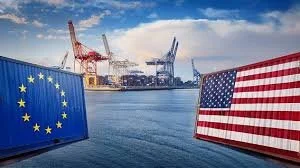A New Chapter in Transatlantic Trade
EU and US Strike Tariff and Trade Deal
What is the US-EU Trade Deal? Is it good deal for the EU?
Contact OpenVentures to learn more about International Expansion
On 27 July 2025, European Commission President Ursula von der Leyen and US President Donald J. Trump reached a landmark political agreement on tariffs and trade — a deal that could reset the tone for one of the most consequential economic relationships in the world.
The EU–US partnership has long been a powerhouse of global commerce. Together, they account for the most significant bilateral trade and investment flow on the planet. In 2024, trade in goods and services surged past €1.6 trillion — that’s over €4.2 billion worth of goods and services crossing the Atlantic every day. This relationship is fuelled not just by trade but by deep investment ties, with EU and US firms investing €5.3 trillion in each other’s markets in 2022 alone.
This latest deal seeks to restore stability and predictability for citizens and businesses on both sides, securing integrated value chains — many driven by SMEs — and safeguarding jobs. While the agreement is not legally binding, it sets the stage for further negotiations and a deeper economic partnership.
Key Outcomes of the July 2025 Agreement
1. A 15% US Tariff Ceiling on EU Goods
From 1 August 2025, the US will apply a maximum 15% tariff on the vast majority of EU exports, replacing the previous patchwork of stacked tariffs. This includes:
Cars and car parts — previously facing up to 25% tariffs, now capped at 15%.
Future-sensitive sectors like pharmaceuticals and semiconductors will remain under only the standard MFN tariffs until further notice.
2. Strategic Product Relief
Tariffs on EU aircraft, certain chemicals, and generic drugs will revert to pre-January levels, offering immediate relief to strategic sectors.
3. Joint Defence of Metals Sectors
To combat global overcapacity, the EU and US will implement tariff rate quotas on steel, aluminium, and copper, halving some duties and ensuring fairer competition.
4. Targeted Market Openings
EU consumers will save €5 billion annually in duties on select US imports.
The EU will remove remaining low-level tariffs on industrial goods.
Limited quota openings for US fishery products and certain non-sensitive agricultural goods worth €7.5 billion — from soya bean oil to cocoa and biscuits — will help EU processors and reduce input costs.
5. Tackling Non-Tariff Barriers
The agreement lays the groundwork for cooperation on automotive standards, sanitary measures, and mutual recognition of conformity assessments.
6. Energy and Technology Security
In a move with geopolitical implications, the EU intends to purchase $750 billion (€700 billion) of US liquefied natural gas, oil, and nuclear products over the next three years — part of its strategy to replace Russian energy sources. Additionally, the EU plans to buy €40 billion in AI chips, reinforcing its technological competitiveness.
7. Investment Boost
EU companies are eyeing $600 billion (€550 billion) in new investments in the US by 2029, adding to the existing €2.4 trillion already committed.
Why This Matters
For businesses, the agreement means more certainty, reduced tariffs in key sectors, and a renewed focus on fair trade practices. SMEs, which form the backbone of many EU–US value chains, stand to gain from reduced trade friction and better market access.
Politically, this deal demonstrates that even in an era of global fragmentation, transatlantic cooperation remains a stabilising force in the global economy. By addressing tariffs, energy security, and technology collaboration in one package, the EU and US are signalling a willingness to balance economic competition with strategic partnership.
The Road Ahead
The 27 July agreement is a political framework, not a finalised treaty. Implementation will require further negotiation and alignment with internal procedures on both sides. Yet, the commitments already in place — from the tariff ceiling to energy procurement — represent tangible wins for industries and consumers alike.
In an uncertain global trade environment, this deal serves as a reminder: the EU–US relationship is not just about economics — it’s about mutual resilience, shared standards, and a long-term strategic vision.

